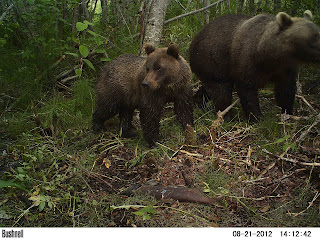Last week, I decided to do some scouting of the area and try to get a better vantage point of the layout of Haines, the Chilkoot and Chilkat Inlets, the Chilkat River, and the various surrounding mountain ranges. The easiest way to do this (aside from renting a plane for a flight-seeing tour... which would be awesome, but too expensive), was to climb Mt. Ripinsky.
Mt. Ripinsky, a 3,650 ft. peak directly north of the city of Haines, is the southern terminus of the Takshanuk mountain range. Although not the highest peak in the range, it's easily the most accessible. There are three different hiking trails that lead to the summit-- two that converge and approach from the south, and an additional trail that approaches from the north. All three trails vary in length and steepness, but the entire trail system is fairly well-maintained and very popular with residents and the more adventuresome tourists that visit the area. Since it's frequently used during summer months, there is also a lower likelihood of encountering brown bear* while on the trail.
Low likelihood or not, I definitely brought along bear spray for the hike. This was one of my first purchases after getting into Haines. I carry it around everywhere I go hiking, even if I'm walking the roads around my neighborhood. Brown bears don't typically frequent human-inhabited areas, but a young, sick, injured, or habituated bear may at any time start checking out the dumpsters, grills, and casts-offs around housing developments for easy food. Better to have it on hand then get caught in a dangerous situation without it.
Rigby and I, along with a friend we met at the
State Fair, hiked the trail to Ripinsky from the southern edge of the range, beginning in town. This 8-mile out-and-back hike took just just over six hours from start to finish, with time spent on the way up taking plenty of photographs and breaking for lunch.
The beginning of the trail lies in temperate rainforest that covers the Chilkat Peninsula. This area sees a lot of precipitation year-round, and so, much like many tropical rainforests, has forested areas with dense undergrowth and many different species of plants, trees, and fungi, as well as numerous creeks and drainage areas.
The trail eventually climbed past tree line, and opened up to gorgeous views of the Chilkoot Inlet. This region is often cloudy and overcast, but I wish the sunlight would have been just a little better-- there were some gorgeous wildflowers blooming once we hit the alpine meadow.
Even during the summer, the area around treeline stays cold. Without trees to buffer winds, temperatures are lower, and even at an elevation of around 2,000 ft., there are snowfields year-round. Rigby, having grown up in California's Central Valley, hadn't ever seen snow. I should have taken a video of his first experience. He went wild for it-- dancing around, digging, sliding on his belly, prancing around like a madman. I can't wait until some of the fresh stuff falls. If he likes the dirty, old, hard-packed stuff this much, I'm sure he'll love it when it's wet and powdery. I'm really looking forward now to snowshoeing with him this fall.

Another thing Rigby hadn't ever seen before was moose! We came across this cow moose and her calf in a pond a few hundred meters off the trail. We were able to watch them feed for a few minutes before they sighted us and moved back into the forest. We weren't close enough for me to get a very good picture, but I'll post the one I took, anyway. If you squint, you can almost tell what they are. We also saw a mountain goat near the summit, but it was definitely too far away to photograph. It blended in too well with the snow.
Once we got up high enough, we had a nice view of Haines from the trail. Here it is!
You can see the cruise ship dock and the harbor in the bay on the left, and the golf course (yes, Haines has a 9-hole golf course) is on the lower right. I live just downhill from this spot, to the right!
Here we are not too far above treeline, with Haines in the background.
Here is a picture looking NNW, up the Chilkat Valley at the Chilkat River. This valley is where we'll be doing most of our research.
And, finally, the summit! You can see the summit marker on the left-hand side of this panoramic photo. The Chilkat Peninsula stretches south out in the middle, and Haines is below, blocked from view by the hillside. On the right-hand side is the Chilkat Range, to the west, and on the left-hand side, the Coast Range, to the east. Even with the clouds, it's a great view!
Rigby was even good enough to pose for me at the top. :)
*Brown bear, grizzly bear, and Kodiak bear are all the same species-- Ursus arctos. Bears that live inland and in mountain ranges are called grizzlies. Coastal bears, like those around Haines, are referred to as brown bears. Kodiak bears live only on Kodiak Island. Some scientists consider them subspecies because of differences in their genetics, diets, and body sizes/coloring. Many people are more familiar with the term grizzly when talking about the species; Regardless, they are all the same species, but since we're on the coast, we'll refer to them as brown bears here.
Labels: Alaska, bears, Haines, Hiking, mountains, nature, Rachel, Rigby, wildlife













































